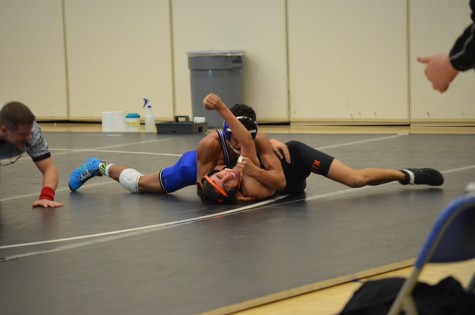Making weight in a wrestling world
After the mats are rolled up and the headgear comes off , the competition isn’t over
Jan 26, 2016
Nate Johnson, junior, starts his day off at 5:30 a.m. with a 20 minute run. From there, he makes two egg whites, toasts a slice of whole wheat bread, and pours himself a glass of orange juice. For Johnson, this early morning routine is an everyday occurrence for the sport he has competed in every winter since seventh grade.
Though most wrestlers begin their career early in life, Johnson began his in junior high.
“I started wrestling my seventh grade year, and for the first two years, I was terrible because of the fact that it was winter. I sucked at basketball, so I chose to try something new. My ninth grade year I really started to pick up the sport; from there on my actual wrestling career started,” Johnson said.
Wrestling is divided up into 14 different weight classes, ranging from the lightest wrestlers, weighing in at 108 pounds, to the heaviest wrestlers, who weigh in at 287.
When Johnson steps on the scale, he tends to see the number 126, even though the weight class Johnson is in is 128. He constantly works on maintaining this weight, otherwise he will not be able to compete.
“Some people think we starve ourselves and throw up, but I have never done that. I eat right and work out hard to try and maintain my weight. I tend to lose about six to nine pounds a week, but it is really not that bad because I eat healthy and stay hydrated,” Johnson said.
The Minnesota State High School League (MSHSL) has recently allowed a new rule for every wrestler in the state. As of 2016, MSHSL allows for all wrestlers to gain two pounds, making each weight class two pounds heavier.
“Even though I’m 126 pounds right now, I have the opportunity to gain two more pounds and be at 128 pounds with this new rule in effect. If I weigh in one day and it shows that I am 128.1 pounds, I will not be able to compete; that’s how strict they are,” Johnson said.
Justin Grunseth, junior, also competes for the Royals wrestling team.
“I chose wrestling because my uncle and dad both used to wrestle, and they both influence me to be the best I can be,” Grunseth said.
Grunseth competes at a higher weight class, weighing in at 152 pounds.
“Weight is a huge part of wrestling – this is why it makes this sport so difficult, because you need to be able to both physically and mentally keep your weight right. Doing this makes this sport more of a skill sport,” Grunseth said.
There are five different ways a person can score points in a wrestling match: the takedown, escape, reversal, near fall, and penalty points. Each wrestler receives various amounts of points by performing these moves.

Nate Johnson, junior, pins an opponent down in the 2014-15 season.
“There isn’t a hardest part of wrestling. Literally everything about it is to be able to grind out the weight, conditioning, and the technique part of the sport,” Johnson said.
All of the wrestlers on the HHS team practice almost every day. Whether it be in the weight room, or just a team practice, being a part of the wrestling team is a full-time commitment.
“There are times in the week where I don’t want to practice because wrestling is such a physical and mental battle, but that’s when you have to embrace the grind of this sport. I dedicate almost every day to wrestling,” Johnson said.
Mr. Al Price, Physical Education, is the head coach for the boys wrestling team. Price started wrestling when he was in seventh grade and has been a coach for the past 36 years.
“I love to see the progress guys make from day to day and from season to season. I love the competitive side of the sport and knowing the wrestler is responsible for what happens in their match, not another teammate,” Price said. “I also love the physical side of the sport. Hard work is solely responsible for your success, accountability, responsibility, and self responsibility. Wrestling is one sport where you compete against another competitor who is your same general size, at least weight wise.”
As a wrestling coach, Price teaches all of the athletes skills and strategies to be able to maintain their weight for upcoming matches.
“All wrestlers must go through body composition testing every year. That is used to determine their lowest possible body fat at seven percent body fat, which is healthy,” Price said. “I try to talk with them about good foods, low fat, high protein, and eating in moderation, not starving, or going without food for long periods of time. I try to impress on them the importance of water in their body and not dehydrating. We try to get them to burn the fat off their bodies to reach their weight in a healthy manner.”
Gabe Herman, freshman, attends NJH. For Herman, this is his first year of competitive wrestling. He wrestles in the 170 pound weight class.
“I was very interested in this sport and have always found it to be something that I wanted to try,” Herman said. “Trying not to eat too much a day or two before the match is key for me, because even though I may be super hungry, I try to mentally tell myself not to eat.”
As for Herman, he has a daily workout that takes place during practice.
“We start with warm-ups, which consist of a bunch of jogging and line drills. Then, we stretch for a while so we can loosen up and then get into our partners and work on various things to get us ready for the next tournament,” Herman said.
Herman faced a minor setback when he sprained his ankle, which held him out for three weeks. As for Herman’s record, he is 0-6 on the season, but says he still has a lot to show and to prove.
“I still have a lot to learn and hope to keep getting better as my high school career continues,” Herman said.

